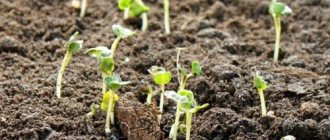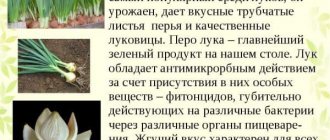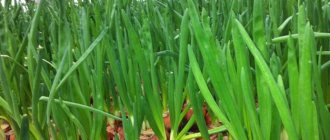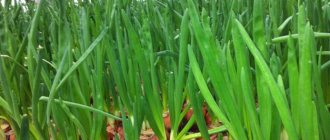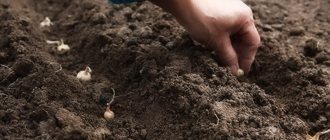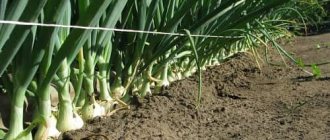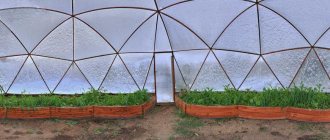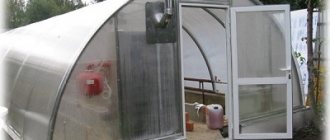- Vegetables
28.09.2020 7811
VK
Many people know that onions can be planted both in spring and autumn. Most gardeners adhere to spring planting dates, but not many practice planting onions before winter. But recently, planting onions before winter has become increasingly popular. And this is not without reason; gardeners were able to appreciate the positive aspects of such planting, and there are several of them.
It is worth noting that when planting any crop before winter, it is important to follow all recommendations regarding timing and planting technology, otherwise you can get sufficient results.
When planting before winter, it is very important to choose a suitable winter variety, determine the optimal time and place for planting, and properly prepare the bed and seed.
Advantages and disadvantages of planting onions before winter
- 1 Advantages and disadvantages of planting onions before winter
- 2 Which onions can be planted before winter 2.1 The best varieties of winter onions
- 2.2 The best varieties of winter onions and characteristics - Table
- 5.1 After what crops can onions be planted?
- 7.1 To prevent shooting
Planting onions before winter has many compelling advantages:
- It is this kind of onion that grows larger and stronger, compared to bulbs planted in the spring;
- When planted before winter, the bulbs undergo hardening in cold conditions. Such plants are already gaining strength by spring, which means they will be more resistant to diseases and pests. That is why onions planted before winter are almost not damaged by the annoying onion fly;
- Another advantage of winter planting is the reduction of weeding. The first onion shoots will appear immediately after the snow melts; the onion will have time to grow and become stronger before the mass appearance of weeds;
Another important factor is that you don’t need to worry about preserving planting material until spring. This is especially important for the smallest fraction of sowing, the so-called “oat”. Such onions will definitely not survive until spring planting; they will simply dry out. Wild oat almost never shoots, and the yield of such sets is not the worst.
- Planting onions before winter significantly saves time during the hot spring season;
- Early harvest. Onions planted before winter ripen in July. The vacated bed can be reused or sown with green manure.
The negative side of such planting is the reduction in onion yields in the event of a harsh winter. If there are sudden changes in temperature or severe frosts, the onion may die. Therefore, it is very important to approach the issue of choosing a variety correctly and not deviate from the recommendations for winter planting.
Another negative point is the inability to plant large bulbs. They almost always go straight. They can only be planted on a feather. But knowing this feature, you can provide yourself with early greens by planting a few large sets separately.
Grown from autumn-planted bulbs, the harvest stores well. But still, spring onions are stored much better.
Varieties and hybrids of winter onion sets
Onion varieties and hybrids are suitable for winter planting:
- early ripening - Bogatyrskaya sila, Bessonovsky, Myachkovsky 300, Odinovets, Siberian annual, Spanish medallion F1, Skorospelka, Stuttgarter Risen;
- mid-season - Danilovsky 301, Carmen MS, Krepysh, Chalzendon, Ecstasy, Tamara F1;
- late ripening - Comet, Lugansky, Rubin (red), Sturon.
What onions can be planted before winter
Sets are usually divided according to the diameter of the bulbs:
- Oatmeal is the smallest onion, less than 1 cm;
- first category - from 1 cm to 1.5 cm;
- second category - 1.5–3 cm;
- samples - more than 3 cm.
For growing onions for turnips, oatmeal and sets of the first category are suitable, for feathers - the second category and selections.
The best varieties of winter onions
Not all onion varieties are suitable for autumn planting. When choosing planting material, you need to purchase seedings of varieties adapted to the climatic conditions of the region.
In the middle zone, the most popular varieties for planting before winter are:
Stuttgarter Riesen, Radar, Arzamassky, Strigunovsky, Danilovsky, Bessonovsky, Ellan, Odintsovets, Senshui, Shakespeare, Red Baron.
Each type of onion has its own taste characteristics, some are more pungent, others are more delicate. If you plant several varieties, in the future you will be able to decide on your preferences: which one tastes better, which one ripens earlier or is more productive. The main characteristics of popular varieties of winter onions are presented in the following table.
The best varieties of winter onions and characteristics - Table
| Onion variety | spicy | size | storage | maturation |
| Arzamas | spicy | small | recumbent | |
| Bessonovsky | spicy | small | recumbent | 80 |
| Buran | spicy | recumbent | 68-83 | |
| Danilovsky | spicy | small | recumbent | |
| Danilovsky-301 | semi-sharp | large | 100-110 | |
| Lugansk | spicy | large | recumbent | 95-105 |
| Muzona | semi-sharp | few | 90-110 | |
| Myachkovsky-300 | 65-75 | |||
| Panther F1 | recumbent | 130-135 | ||
| Radar or Raider | spicy | recumbent | 250-260 | |
| Red Baron | spicy | large | recumbent | 95-110 |
| Ruby | semi-sharp | average | average | 80-90 |
| Senshui | spicy | large | recumbent | |
| Siberian | recumbent | 90-100 | ||
| Strigunovsky | spicy | average | recumbent | 110-120 |
| Sturon | semi-sharp | average | recumbent | 105-110 |
| Tamara F1 | 105-110 | |||
| Chalcedony | spicy | average | recumbent | 90-95 |
| Black Prince | semi-sharp | 100-105 | ||
| Shakespeare | semi-sharp | large | average | |
| Stuttgarter Riesen | spicy | average | recumbent | 70-120 |
| Ellan | sweet | recumbent |
Varieties
Most varieties are suitable for autumn planting of onions. Choose cold-hardy ones that are zoned for your area. Southern onion varieties are less adapted to wintering. If you find it difficult to choose, just take seedlings grown by local summer residents.
List of onion varieties that are reliable and resistant to winter planting:
- Myachkovsky 300. Early cold-resistant variety for universal use. It produces attractive bulbs measuring about 70 g, and is quite productive - up to 3 kg per sq.m.
- Arzamas . A variety of folk selection. The bulbs form medium-sized nests (2-3 pieces per nest) and are well stored.
- Odintsovets . Widespread, early productive variety (up to 3.6 kg per sq. m). The bulbs are round, with an average weight of about 80 g. They can be grown from seeds, used for forcing (for feathers).
- Strigunovsky . An ancient early ripening variety, resistant to cold and bolting. Small-growing (usually forms 1 bulb), productive, shelf-stable, with a pungent taste. Bulbs of small and medium size, 50-80 g. Also used in annual crops - sowing from nigella. Very popular among people, grown everywhere.
- Timiryazevsky . Early ripening, productive variety, early ripening. Small-growing, forms dense round-flat bulbs weighing 50-70 g, with a pungent taste. Ripens reliably and is very shelf-stable.
- Stuttgarten Riesen . Widespread, highly productive variety with a spicy taste. Forms large (up to 100 g), flat-rounded bulbs. Early and cold-resistant, reliable in the middle zone. Yields in any weather - about 3.5 kg per m2.
Stuttgarter Risen is an early, cold-resistant and large variety.
Hobbyists have successfully tested varieties of Russian and foreign selection on their plots - Carmen, Kip Well, Silver Prince, Radar, Chalcedony, High-Keeper, Stardust set and many others.
For pre-winter planting of onions, do not use varieties of annual or seedling cultivation (Exhibition), as well as shallots, or heirloom onions, since large onions bolt in the spring.
Planting onions before winter: optimal timing
When planting onions before winter, it is very important to determine the timing correctly.
If planted early, the bulb will have time to germinate. And if planting is delayed, it will not have time to take root before frost. In both cases, the onion may not survive the winter well, which will negatively affect the harvest in the future.
When planting onions before winter, you need to choose a time so that the onion has time to form roots before the soil freezes, but cannot germinate. If the feather of the bulb grows 1-2 cm, there is nothing terrible about it. If the planting depth is observed, such a bulb will overwinter normally. It is much worse if the bulb grows significantly. Beds with such onions must be mulched to avoid their death. And in winter, you can add additional snow to such beds.
In order to correctly determine the date of planting, you need to focus on current temperature conditions and the weather forecast.
Planting can begin if the temperature is around +5°...+7°C for several days, and a gradual decrease in temperature is expected.
To determine the time for planting onions in different regions, you need to focus on the climatic conditions of the region and the current weather conditions at the moment.
So in the middle zone this is a period from approximately the end of September until the 20th of October.
In any case, you need to plant onions at least a month or even a little more before the onset of cold weather.
To make it easier to figure out timing, try planting onions at different times. By analyzing the results, you can experimentally determine the optimal time for planting winter onions in your area.
When to plant
In each region, and even within a region, in different years, the autumn planting of onions falls on different dates, for example, for the middle zone on October 5–20. But this does not help at all, because the run-up is as much as 2 weeks, during which time the onion can germinate and freeze out safely. Therefore, we look not at the calendar, but at the thermometer outside the window.
The air temperature should remain stably (several days) below +5 °C, frosts are possible at night. Just in case, check the weather forecast for the week ahead; if no warming is expected, you can start planting.
There is one more recommendation: onions should be planted a month before the arrival of cold weather, when temperatures below zero during the day are already established. In my opinion, this is useless advice. If weather forecasters can’t guess what will happen to the weather even tomorrow, then how can a simple gardener get his bearings and understand: there is a month left before the cold weather or not?
What to do if you are late planting onions?
If for some reason you did not have time to plant onions before winter, then you need to act according to the circumstances.
If there have not been frosts yet, then the ground must be carefully covered so that it does not freeze. For these purposes, a layer of compost (of course, preferably thicker), humus, covering material folded several times and other materials is suitable.
Experienced summer residents advise that if there are not a lot of onions, then you can bring a couple of buckets of earth into the house, to the stove. The next day, when the earth has warmed up, you can plant, spreading the heated soil directly into the furrows.
If there is a lot of onions, then it is better to sort them out. Leave the large ones until spring, and plant the small ones.
You need to be wary of the advice to “spill the ground with hot water.” In damp conditions, the bulbs may rot.
Shelter of planted planting material
There is no need to rush to cover winter onions immediately after planting. If this is done too early, the planting material will simply rot in the event of an unexpected warming. As a rule, the beds begin to be covered when the first frost begins to grip the soil.
The best cover for a bow is snow. A layer of even a couple of centimeters will be enough to protect against severe frost down to -15 C.
If frost sets in and there is still no snow, then for insulation, in addition to special material, literally everything that is at hand (dry leaves and plant stems, seed husks, etc.) will do. But it is better to use spruce branches in combination with dry leaves.
How to plant onions before winter
After what crops can onions be planted?
It is very good to plant winter onions in a bed where cucumbers, tomatoes, corn, beets, and grains previously grew. It is not recommended to plant it after onions, cabbage, and garlic.
When growing onions, it is very important to observe crop rotation. You cannot plant onions in one place year after year.
How to choose a place and prepare a bed for planting onions
Just like for garlic, you need to choose a bed for planting onions in a sunny place at a slightly elevated position. Under no circumstances should you choose areas where water stagnates in the spring. Like all bulbous plants, onion sets will simply rot in such conditions.
It is advisable to choose a place on the site so that in the spring the snow melts there as early as possible.
The bed for autumn planting of onions must be prepared in advance so that the soil has time to settle.
If you plant onions immediately after digging up the ground, there is a risk that the soil will later become compacted and settle. The onion will end up on the surface of the soil and freeze.
Onions prefer fertile and loose soil with an acidity close to neutral. If the acidity is high, then you must add lime or dolomite flour.
To improve the soil, compost or humus is added before digging - 5-6 kg per m².
As for fertilizers, add fertilizers from the “Autumn” series or superphosphate 20-25 g per 1 sq. m. meter and potassium salt 10-15 g. Potassium fertilizers can be replaced with ash, which also helps reduce soil acidity and serves to prevent various rots.
It is advisable to make the beds raised to a height of up to 15 cm; water is guaranteed not to stagnate on such beds. If the soil is dense and heavy, then creating raised beds is simply necessary.
Soil preparation
It is advisable to prepare the onion bed 2-3 weeks before planting:
- First, humus is added to the site at the rate of 5.5 kg per m².
- Then 14 g of potassium sulfate and 23 g of superphosphate are evenly scattered over each square meter.
- You can add ash at the rate of 10 g per 1 m².
After spreading the fertilizer, you need to dig up the area. Novice vegetable growers are interested in how deep they should dig the soil? The onion does not need deep digging; it is enough to deepen the shovel 20 cm.
Important! It is advisable to slightly raise the winter ridges of onions to protect the crop from spring flooding.
How to prepare onions for planting
Preparing seedlings for winter has its own characteristics. First of all, it needs to be visually inspected - the seed must be dry, hard, without signs of rot. Sick, damaged, dried onions must be removed from the planting material.
Then it needs to be calibrated, divided by size: separate the small ones - wild oats, sets and selections. Part of this seedling will be used for turnips, the other for growing greens.
- wild oatmeal (up to 1 cm in diameter) - on the head (turnip);
- sevok (diameter from 1 to 2 cm) - on the head and partly on the feather (greens);
- large (diameter more than 2-3 cm) - only for greens (very early).
| Important! The larger the size of the bulb, the better the greens will be; if the fractions are too small, the feather will take a very long time to develop and will be quite small. |
Pre-sowing preparation of onion sets is a very important stage. And it is as follows:
- Sorting and sizing . Dry, rotten bulbs are removed and the seed is arranged according to size. They should not be planted interspersed, but in different places. The largest ones are best used on a pen. They are more likely to be shot. And the smallest sets are best suited for autumn planting and produce large heads.
- Warming up onion sets . This is carried out in order to “wake up” the seeds and this operation prevents the onion from bolting. Can be placed where the temperature is 20°C for at least 20 days. Then for 10 hours to where it is about 40°C. You can quickly rinse with very hot water and dry.
- Hardening . Dip the bulbs in water at a temperature of 45-50°C for 15 minutes. After this, leave in cold water for the same time. Cold and hot shower;
- Onion processing, disinfection. It is done in order to protect the seedlings from damage by fungal diseases. This soaking is carried out immediately before planting. Typically, a slightly pink solution of potassium permanganate or a pale blue solution of copper sulfate (from late blight) is used for this. Leave the sets in the solution for 2-3 hours. After this, you need to dry the bulbs well.
- Using saline solution. To reduce the risk of plant infection with stem or onion nematodes. Preparation of the solution: take 1 tablespoon of table salt per 1 liter of water. Immerse the onion sets in the mixture for 10-20 minutes. You can use baking soda instead of salt.
Common mistakes
- Too much watering after planting. This leads to fungal infection and the development of rot.
- Lack of moisture after autumn planting. It is also impossible to leave the sets without water. The planting material will dry out.
- Use fertilizers when planting, not when preparing the bed. Because of this, the onion produces feathers, which is completely unnecessary before winter.
- The bed is not loosened. The bulb remains without oxygen and freezes in development.
- Choosing the wrong variety. In order to get a harvest and not ruin your seedlings, you need to select the right zoned winter varieties that are intended for planting specifically in your region.
- Error with the selection of the landing date. Sowing must be done so that the bulbs have time to take root, but do not have time to release the feather.
- Onions are not planted upside down. It's a stupid mistake, but it happens too. The bulb is planted bottom down and lightly pressed down for better contact with the soil.
Prevention of bolting and diseases
The following measures are necessary to prevent diseases and prevent bulbs from bolting in the spring
To prevent shooting
- Dip the bulbs in a warm solution of potassium permanganate (50-60°C) for 20 minutes, when planting, pour hot water into the grooves
- In order for the seedlings not to go to waste, they need to be warmed up well at a temperature of 50-60°C before planting. I usually hang it in a canvas bag near the battery for 2-3 days, so that the bag does not touch the battery. It dries out at the same time.
For disease prevention
- Treatment with the drug “Maxim”, “Fitosporin” according to the instructions. Immerse the seed in a saline solution (1 tablespoon of salt per 1 liter of water) for 3 hours, then in a saturated solution of potassium permanganate for 3 hours.
| Important! In autumn, seedlings need to be treated 7-10 days before planting. Then it must be dried. |
Dry bulbs withstand sudden cold spells better than swollen bulbs, and the latter may begin to germinate too quickly.
Harvesting and storage features
Winter onions are harvested when the husks acquire the density and color characteristic of a particular variety. Lodging of leaves is also a clear sign.
The onions are carefully dug up with a pitchfork, and simply pulled out of the loose soil by the leaves. After this, it is allowed to rest for 1-2 days so that the soil dries and crumbles, and then the leaves and roots are carefully trimmed with scissors or pruning shears. If you plan to store the onions tied into braids, it is not necessary to trim the leaves. The roots are always removed. It is important not to damage the bulb.
After trimming, the onions are dried for 3-5 days in the sun or, if the weather is rainy, under a canopy. Then it is stored in a cool, dry room.
Planting onions before winter - technology
Planting onions before winter - description of technology :
- To plant, you need to level the bed, then make holes or cut grooves according to the scheme:
- the distance between the grooves is 15-25 cm. This is the optimal distance for processing row spacing with a flat cutter when caring for onions in spring;
- groove depth - 5-8 cm (depending on the size of the bulb). Before winter, the planting depth should be greater than when planting in spring. For the smallest set - wild oatmeal, make the furrows no deeper than 2-3 cm, otherwise it will not have enough strength to germinate in the spring;
- the distance between the bulbs is 7–8 cm. You can plant onions more often. Then in the spring, when thinning out the plantings, some of the onions can be used for greens.
- When planting onions only on the feather, the distance between the onions is slightly different. They are placed closely so that in the spring the plant directs its forces not to the growth of the bulb, but to the feather.
- Spread or stick in the sets. If you have heavy clay soil, then it is advisable to pour river sand at the bottom of the beard, then add more sand on top of the bulb. All bulbous crops prefer loose soil. This technique will help avoid the death of the onion from waterlogging in heavy, damp soil.
| Before planting, you cannot cut off the neck of the bulbs, otherwise you will get a feather instead of a turnip. |
3. Sprinkle the bulbs with soil and compact them lightly. Level the bed with a rake so that the bulbs emerge evenly in the spring.
- If the soil is relatively moist, then there is no need to water, so as not to provoke strong plant growth. If there is no rain, then 10 days after planting you will need to water the bed.
- The beds can be sprinkled with humus, compost or sawdust.
Features of autumn planting of large sets on a feather
To obtain greenery in the spring, use samples of 3-4 cm in size. The bulbs are placed on the bed:
- bridge method - planted close to each other;
- tape - selections are placed at a short distance between the bulbs in a row, grooves are made in increments of 20-25 cm;
- nesting method - the onions are planted side by side, 3-4 pieces at a time, with an interval of 15 cm in a row, furrows are made at a distance of 20-25 cm.
Before planting, the tail is cut off and the outer scales are partially removed.
Caring for onions after planting
Winter onions do not require special care after planting. It is necessary to cover the beds with planted onions only when the soil freezes slightly. Immediately after planting, you should not cover it, as the onions can get wet. .
After the onset of light frost, you need to mulch the bed with fallen leaves, spruce branches, dry tops, dry sawdust, straw, peat or other materials. Cover the top with branches, poles, etc. (to hold snow). In winter, you need to throw snow on the garden bed; this is the best protection against freezing.
| Note! The need for mulching and shelter for the winter depends on the climate of our region. If you have snowy winters without much frost, then you don’t have to cover them with anything. |
With the onset of spring, when the snow melts and the soil begins to thaw, all coverings should be removed, because the ground underneath, on the contrary, will only take longer to warm up.
The mulch also needs to be removed so that the soil warms up faster. After the emergence of seedlings in early spring, it is necessary to fertilize the bed.
Care
In winter, beds of onion sets do not need special care, except to adjust the film if necessary and make sure that the soil is not left bare. In the spring, the main thing is to maintain the correct timing for removing the cover. If you remove it too late, the onion will become soaked and the sprouts will be delayed in passing through the soil layer. Early “stripping” of the bed can lead to damage to the crops by returning cold weather.
When spring warming comes and the soil warms up, the film is removed, and a week later the mulched cover is removed. The open ground is loosened and 10 g of wood ash per square meter is added. Watering is done as needed if there is no rain and the soil dries out. Every rain or watering is a signal for loosening; it is good to remove weeds at the same time.
As soon as four leaves have formed, you can fertilize the beds a second time, since this is a sign that the bulb in the soil has begun to form. For feeding, the same mineral fertilizers are used - potassium and superphosphates - as in the fall, and in the same proportion. It is better if granular fertilizers are dissolved together with ash in the fermented grass before being applied to the soil. A necessary condition is thinning of thickened crops. The pulled out onion is suitable for preparing delicious vitamin salads and just for eating.
As an alternative to mineral fertilizers, you can consider chicken manure, which should be liquid and not too concentrated. If there is sufficient rainfall, you can water the onion beds occasionally, but a warm and dry spring is a reason to water the beds twice a week.
To protect the beds from the onion fly that appears in the spring, the area where the branch sets are planted is surrounded with flowers that repel pests. Optimally, these are calendula and marigolds.

